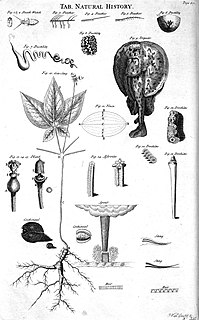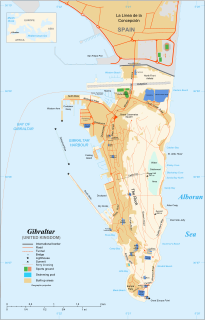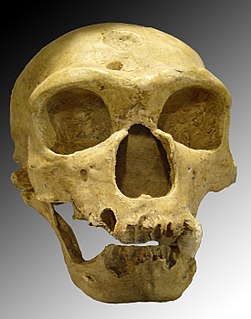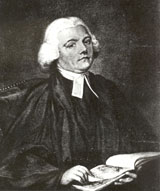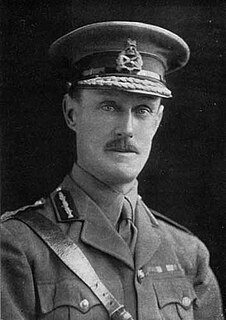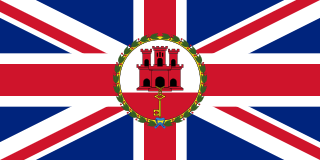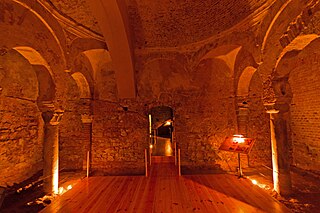
Gorham's Cave is often mistaken for a natural sea cave, but is in fact a sea level cave, in the British Overseas Territory of Gibraltar. It is considered to be one of the last known habitations of the Neanderthals in Europe. It gives its name to the Gorham's Cave complex, which is a combination of four distinct caves of such importance that they are combined into a UNESCO World Heritage site, the only one in Gibraltar. The three other caves are Vanguard Cave, Hyaena Cave, and Bennett's Cave.

Prof. Clive Finlayson MBE FLS is a Gibraltarian zoologist, paleoanthropologist and paleontologist. He is the incumbent Director of the Gibraltar Museum. Finlayson has published various works mainly based on his research which includes ongoing excavations at Gorham's Cave in Gibraltar, the last known site of the Neanderthals.
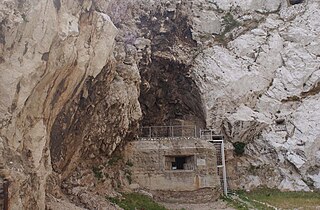
Forbes' Quarry is located on the northern face of the Rock of Gibraltar within the Upper Rock Nature Reserve in the British Overseas Territory of Gibraltar. The area was quarried during the 19th century to supply stone for reinforcing the fortress' military installations. In the course of the quarrying, a limestone cave was found. The second ever Neanderthal discovery was made within this cave when Cpt. Edmund Flint found the skull of an adult female Neanderthal in 1848.

Vanguard Cave is a natural sea cave in the British Overseas Territory of Gibraltar which is part of the Gorham's Cave complex. This complex of four caves has been nominated as a UNESCO World Heritage Site status in 2016. The cave complex is one of the last known habitations of the Neanderthals, with a period of inhabitation from 55,000 to 28,000 years ago. It is located on the southeast face of the Rock of Gibraltar.
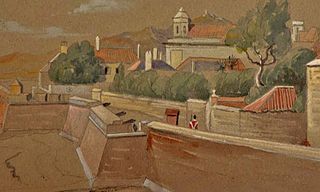
The Line Wall Curtain is a defensive curtain wall that forms part of the fortifications of the British Overseas Territory of Gibraltar.

Geraldine Finlayson is Deputy Head of Heritage, as well as Director of the Institute for Gibraltarian Studies and Chief Laboratory Scientist of the Gibraltar Museum. She was Director of the John Mackintosh Hall until October 2011. She has played a major role in developing the "Gibraltar method" of archaeological research, especially that carried out underwater, and is one of a team of scientists who have made major discoveries about the nature of Neanderthal culture.

Nun's Well is an ancient underground water reservoir in the British Overseas Territory of Gibraltar. It is located at Europa Point, and is thought to be of the Moorish period. It represents some of the earliest evidence of an artificial water supply in Gibraltar. The name of the cistern is thought to be derived from the nuns associated with the Shrine of Our Lady of Europe. In the eighteenth century, Nun's Well supplied the military with water. In the early nineteenth century, it provided water for the brewery that was built next door. In 1988, the Royal Engineers constructed what is now the main building, which has a castle-like appearance. Nun's Well became the focus of controversy during the 2010-2011 restoration of the site.

The Charles V Wall is a 16th-century defensive curtain wall that forms part of the fortifications of the British Overseas Territory of Gibraltar. It was built in 1540 and strengthened in 1552 by Holy Roman Emperor Charles V. The wall remains largely intact and extends from South Bastion, which was once at the water's edge in the harbour, to the top ridge of the Rock of Gibraltar.

The Gibraltar Nature Reserve is a protected nature reserve in the British Overseas Territory of Gibraltar that covers over 40% of the country's land area. It was established as the Upper Rock Nature Reserve in 1993 under the International Union for Conservation of Nature's category Ia and was last extended in 2013. It is known for its semi-wild population of Barbary macaques, and is an important resting point for migrating birds.

The Moorish Wall, also known as the Philip II Wall and formerly the Muralla de San Reymondo is a defensive curtain wall built in the 16th century that formed part of the southern fortifications of the British Overseas Territory of Gibraltar. It was completed by 1575. The wall ran from the top of a steep cliff above the lower section of the Charles V Wall up the slope of the Rock of Gibraltar to its crest, north of the upper section of the Charles V Wall and is now within the Upper Rock Nature Reserve.

The Gibraltar Heritage Trust is a non-profit charity established by statute on 1 May 1989 to preserve and promote the cultural natural heritage of the British Overseas Territory of Gibraltar.
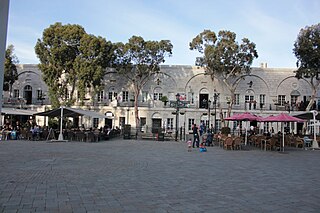
The Grand Casemates is a building in Grand Casemates Square, Gibraltar, that was originally a fortified barracks and casemate. It is beside Grand Casemates Gates, which leads through the former town wall.
The Gibraltar Caving Group is an organisation based in the British Overseas Territory of Gibraltar. It forms the Caves and Cliffs Section of the Gibraltar Ornithological and Natural History Society. The group of skilled cavers and climbers has multiple roles, engaging in cave exploration and research, avian rescue, and rare plant discovery. It performs surveys and clears areas with limited access. However, it is perhaps most well known for the discovery that four of its members made in December 1996. While exploring tunnels in the southern portion of the Rock of Gibraltar, they found the entrance to Operation Tracer, also known colloquially as Stay Behind Cave. Rumours of a covert World War II observation post had circulated in Gibraltar for decades. The Gibraltar Caving Group continued its exploration and evaluation of the facility under the auspices of the Gibraltar Museum.

Ibex Cave is a limestone cave on the Rock of Gibraltar which has yielded stone artifacts of Mousterian tradition. It was discovered in 1975. It is so named as an ibex skull was found within the cave which would have been hunted by the Neanderthals of Gibraltar thousands of years ago. Ibex Cave was named and excavated by the Gibraltar Museum in 1994. Its first formal description was in 1999.

Grand Battery is an artillery battery in the British Overseas Territory of Gibraltar. To the west of the grand battery was a very formidable flank which was considered to have been a "great annoyance to the besiegers."

The Neanderthals in Gibraltar were among the first to be discovered by modern scientists and have been among the most well studied of their species according to a number of extinction studies which emphasize regional differences, usually claiming the Iberian Peninsula partially acted as a “refuge” for the shrinking Neanderthal populations and the Gibraltar community of Neanderthals as having been one of many dwindling communities of archaic human populations, existing just until around 42,000 years ago. Many other Neanderthal communities went extinct around the same time.

The Prince's Lines are part of the fortifications of Gibraltar, situated on the lower slopes of the north-west face of the Rock of Gibraltar. They are located at a height of about 70 feet (21 m) on a natural ledge above the Queen's Lines, overlooking the landward entrance to Gibraltar, and run from a natural fault called the Orillon to a cliff at the southern end of the isthmus linking Gibraltar with Spain. The lines face out across the modern Laguna Estate, which stands on the site of the Inundation, an artificial lake created to obstruct landward access to Gibraltar. They were constructed to enfilade attackers approaching Gibraltar's Landport Front from the landward direction.



